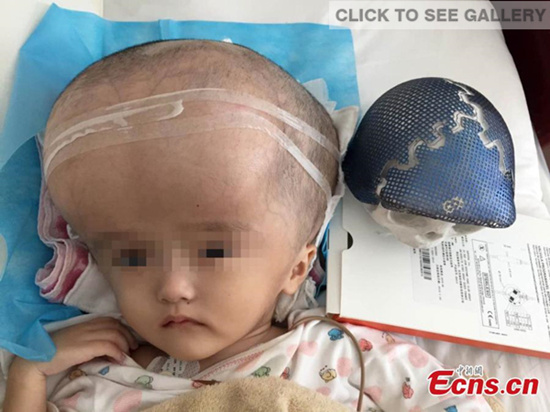A three-year-old girl with an abnormally large head undergoes surgery at a hospital in Changsha city, capital of Central China's Hunan province, July 15, 2015. (Photo provided to China News Service)
A toddler in central China's Hunan Province has become the first person in the world to have her cranium successfully reconstructed with the help of 3D printing technology.
Three-year-old Han Han suffers from congenital hydrocephalus, a condition that causes an abnormal amount of fluid to build up in the brain.
This condition has left her bedridden, as her neck cannot support the weight of her head, which has grown to four times its normal size. Her head weighs about 20 kg while she weighs only 32 kg.
The pressure of the excess fluid also resulted in infections that could put her at risk of going blind.
But surgeons at Hunan's Second People's Hospital based in the city of Changsha are trying to fight the condition's effects with a 3D-printed skull implant.
They used 3D printing equipment to create a model of the girl's skull, which they then used to design a titanium mesh to replace Han Han's cerebral cranium, otherwise known as the part of the skull that protects the brain.
The surgeons removed a portion of her skull and put the mesh in place in a 17-hour operation that ended at about 2:20 a.m. Wednesday.
"After the skull is removed, the brain is like an egg that's been peeled. It's wobbly and unstable. We have to drain excess fluid so the membrane can hold tight and prevent the brain from moving too much. We also have to keep the skull pressure at the right level," said Kuang Weiping, a surgeon participated in the operation.
The doctors had to drain 7.5 liters of fluid from the girl's head during the operation, a procedure which took four hours.
They left the facial cranium intact as a base in order to secure the titanium mesh, said Kuang.
The surgeons said they divided the mesh into three parts in order to make the implantation process easier and make the mesh more stable.
The surgeons said they used an adult-sized skull implant, since Han Han is still growing. They said the extra scalp tissue can be used to help repair her head as it becomes smaller.
The girl is still in intensive care following her operation.

















































